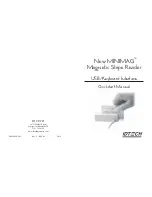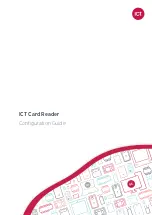
ACR1281U-C1 – Application Programming Interface
Version 1.08
www.acs.com.hk
Page 10 of 96
4.0. Hardware Design
4.1. USB
The ACR1281U-C1 connects to a computer through USB following the USB standard.
4.1.1.
Communication Parameters
The ACR1281U-C1 connects to a computer through USB as specified in the USB Specification 2.0.
The ACR1281U-C1 is working in full-speed mode, i.e. 12 Mbps.
Pin
Signal
Function
1
V
BUS
+5 V power supply for the reader
2
D-
Differential signal transmits data between ACR1281U-C1 and PC
3
D+
Differential signal transmits data between ACR1281U-C1 and PC
4
GND
Reference voltage level for power supply
Table 1
: USB Interface Wiring
Note:
For ACR1281U-C1 to function properly through USB interface, the device driver should be
installed.
4.1.2.
Endpoints
The ACR1281U-C1 uses the following endpoints to communicate with the host computer:
Control Endpoint
– For setup and control purposes.
Bulk-OUT
– For commands to be sent from host to ACR1281U-C1 (data packet size is 64 bytes).
Bulk-IN
– For response to be sent from ACR1281U-C1 to host (data packet size is 64 bytes).
Interrupt-IN
– For card status message to be sent from ACR1281U-C1 to host (data packet size is 8
bytes).
4.2. Contact Smart Card Interface
The interface between the ACR1281U-C1 and the inserted smart card follows the specifications of
ISO 7816-3 with certain restrictions or enhancements to increase the practical functionality of the
ACR1281U-C1.
4.2.1.
Smart Card Power Supply VCC (C1)
The current consumption of the inserted card must not be any higher than 50 mA.
4.2.2.
Card Type Selection
Before activating the inserted card, the controlling PC always needs to select the card type through
the proper command sent to the ACR1281U-C1. This includes both memory card and MCU-based
cards.
For MCU-based cards the reader allows to select the preferred protocol, T=0 or T=1. However, this
selection is only accepted and carried out by the reader through the PPS when the card inserted in
the reader supports both protocol types. Whenever a MCU-based card supports only one protocol
type, T=0 or T=1, the reader automatically uses that protocol type, regardless of the protocol type
selected by the application.











































